October 9, 2014
by Carole Zangari -
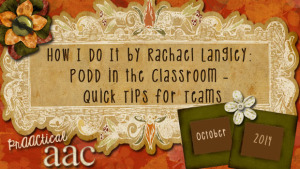
Today we welcome SLP Rachael Langley, who has been working in the public schools as a speech-language pathologist for over 12 years. Currently working as an AAC Specialist in Mid-Michigan, Rachael tells us that she strives to spread the message about the importance of AAC and unlocking the communication potential of all students. In this post, Rachael shares some of her best tips for building communication with learners who are getting started with PODD books. The PODD system offers a complete language approach through carefully organized symbol sets. Because the PODD system promotes a language immersion model, there is no pressure on our language-learners reproducing specific words or patterns at a specific rate. Here are some quick tips I share with classroom teams who are starting out with PODD: Input before output! Model, model, model! – Without digging too deep into the importance of Aided Language Stimulation, we want to make sure... [Read More...]
Filed under: PrAACtical Thinking
Tagged With: classroom, PODD, Rachael Langley
October 8, 2014
by Carole Zangari -
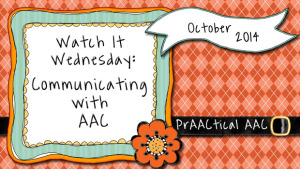
There is no better time that AAC Awareness Month to see and hear directly from people who use AAC. A lot of focus is on children and education, but this is a great reminder that no one is too old or too anything to learn to improve their communication skills. Thanks to Deanna Wagner, (who has done some terrific posts for us here, here, and here), and her clients at the Valley of the Sun School and Habilitation Center for making this video and sharing it with the rest of us.
Filed under: PrAACtical Thinking
Tagged With: adults, Deanna Wagner, first person account
October 7, 2014
by Carole Zangari -
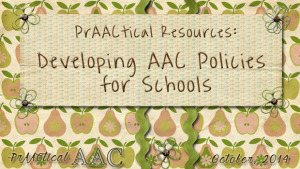
As much as we appreciate spontaneity, it is sometimes true that well-conceptualized policies and procedures help things run more smoothly. Today, we head to the UK where the ACE Centre has developed a comprehensive guidebook to help schools develop good AAC policies. Obviously, the specifics will vary based on the locale, but there is much to be gained from this thoughtful approach. Take a look. https://acecentre.org.uk/resources/developing-aac-policies-schools/
Filed under: PrAACtical Thinking
Tagged With: ACE Centre, education, policy, schools
October 6, 2014
by Carole Zangari -
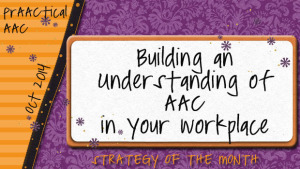
October is International AAC Awareness Month and giving us the perfect opportunity to go beyond our normal therapy-assessment-paperwork routine to spread awareness of AAC. Here are some thoughts for how to do that in the workplace. Inform: You’re probably already spreading the word about AAC as often as you can, but here are a few more ideas to help others gain an understanding of what can be done to support people with little or no functional speech. Create a brief AAC-related public service message that is delivered on morning announcements or staff meetings (E.g., “Everyone communicates, but some students with disabilities have difficulty talking. Did you know that just because some students can’t talk, they can still understand what you say? Special technology is sometimes used so they can better express themselves. Not only does that help them in the moment, but it may also improve their ability to talk”).... [Read More...]
Filed under: PrAACtical Thinking
Tagged With: AAC Awareness Month
October 5, 2014
by Carole Zangari -
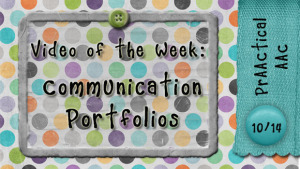
Helping teams to get to know the communication abilities of our AAC clients is something many of us struggle with. In this video from The Perkins School, we learn about their process for developing communication portfolios. http://www.perkins.org/resources/webcasts/communications-portfolio.html
Filed under: PrAACtical Thinking
Tagged With: assessment, beginning communicator, Perkins, portfolio, teaming, teams
October 4, 2014
by Carole Zangari -
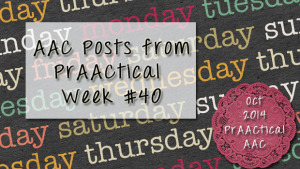
Sunday: Video of the Week – Using Eye Gaze Monday: Strategy of the Month – Engagement Take-Aways Tuesday: Teach Me Tuesday – DynaVox Eyemax Wednesday: 2014 AAC Awareness Month Celebration Thursday: The Faces of AAC – Justyna and Wiktoria Friday: Fun Friday – Successful Interactions
Filed under: PrAACtical Thinking
October 3, 2014
by Carole Zangari -
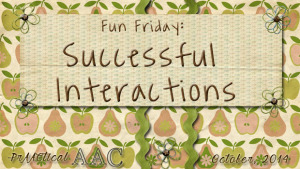
Friday is a great day to pause for a bit of fun. I had the opportunity to meet Janelle Sampson, of Two Way Street, this spring and learn a little bit about the work that she does. In this post, we share a video of one of her little friends using various modalities to communicate with his mother and brother. Enjoy this wonderfully prAACtical interaction! Big Words for Little Boys: https://www.youtube.com/watch?v=5FWimeCvbIY
Filed under: PrAACtical Thinking
Tagged With: Fun Friday, interaction, Multimodal, vocabulary
October 2, 2014
by Carole Zangari -
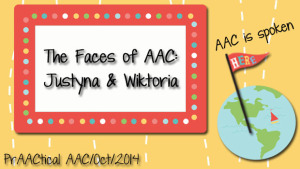
What better way to promote AAC awareness than to share the faces of people who use AAC and the SLPs who serve them? Today, we go to Poland to visit with Justyna Puchalka, who has a private practice in Bielsko, and her young client, Wiktoria. Justyna has been working as a speech therapist for almost 10 years, mostly with young children who have a range of conditions including Down Syndrome, Prader Willi, cerebral palsy, autism and multiple disabilities. Justyna shared that she is very passionate about her work. “Because ‘my children’ make my work a challenge and, thus, my work gives me much satisfaction, not to mention that I simply like to help these children and their parents.” Justyna made a video to share some thoughts about Wiktoria’s AAC journey. Many thanks to Justyna, Wiktoria, and her family for helping us celebrate AAC Awareness Month! Direct link tovideo: https://www.youtube.com/watch?v=0eLE2nlA6R8
Filed under: PrAACtical Thinking
Tagged With: AAC Awareness Month, Faces of AAC, Justyna Puchalka, Poland
October 1, 2014
by Carole Zangari -

Could it really be October already?! Let’s start off AAC Awareness Month with a giveaway. We are so grateful to the following organizations for donating raffle prizes for this drawing. Please take a moment to thank them. Aacorn Ablenet Alexicom Appy Therapy Choice Works/Bee Visual Hump Software Lesson Pix News 2 You Safe N Sound Mobile Saltillo Smarty Ears Speak For Yourself Speak MODalities SpeechPathology.com Speech Tree Apps TapSpeak Therapy Box Tobii-Dynavox How Does It Work? We use Rafflecopter to administer the giveaways. All entries made through there will be counted toward our drawings. Once we’ve drawn our winners, we’ll send an email to each one. You’ll need to be a good sport to play along because we’re not going to get into requests for specific prizes or substitutions. (As I learned from wise-beyond-her-years Pauleen, “You get what you get, and you don’t get upset.” Love that!) The winners will... [Read More...]
Filed under: PrAACtical Thinking
Tagged With: AAC Awareness Month, Giveaway
September 30, 2014
by Carole Zangari -
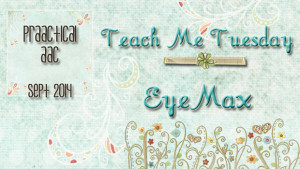
Ready to learn more about the EyeMax from DynaVox? Eye Max User Guide Series 5 User Guide Series 5 Training Manual Series 5 Full Manual InterAACt Guide Where to Go for Help: Search the Knowledge Base, Live Chat, Phone (800-588-4548)
Filed under: PrAACtical Thinking
Tagged With: EyeMax, Teach Me Tuesday









